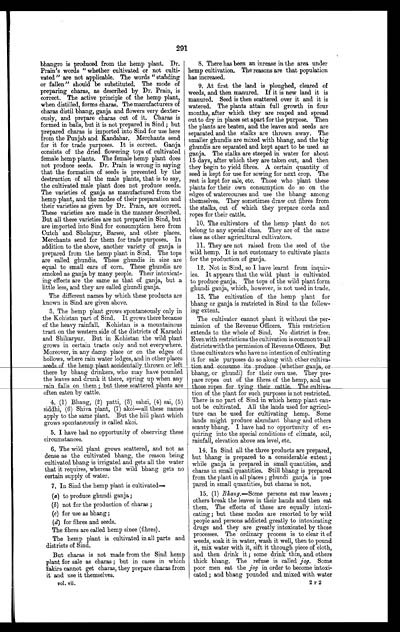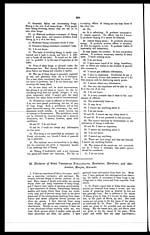Medicine - Drugs > Report of the Indian Hemp Drugs Commission, 1894-1895 > Volume VII > Evidence of Sind witnesses
(309) Page 291
Download files
Individual page:
Thumbnail gallery: Grid view | List view

291
bhangro is produced from the hemp plant. Dr.
Prain's words "whether cultivated or not culti-
vated" are not applicable. The words "standing
or fallen" should be substituted. The mode of
preparing charas, as described by Dr. Prain, is
correct. The active principle of the hemp plant,
when distilled, forms charas. The manufacturers of
charas distil bhang, ganja and flowers very dexter-
ously, and prepare charas out of it. Charas is
formed in balls, but it is not prepared in Sind; but
prepared charas is imported into Sind for use here
from the Punjab and Kandahar. Merchants send
for it for trade purposes. It is correct. Ganja
consists of the dried flowering tops of cultivated
female hemp plants. The female hemp plant does
not produce seeds. Dr. Prain is wrong in saying
that the formation of seeds is prevented by the
destruction of all the male plants, that is to say,
the cultivated male plant does not produce seeds.
The varieties of ganja as manufactured from the
hemp plant, and the modes of their preparation and
their varieties as given by Dr. Prain, are correct.
These varieties are made in the manner described.
But all these varieties are not prepared in Sind, but
are imported into Sind for consumption here from
Cutch and Sholapur, Barsee, and other places.
Merchants send for them for trade purposes. In
addition to the above, another variety of ganja is
prepared from the hemp plant in Sind. The tops
are called ghundis. These ghundis in size are
equal to small ears of corn. These ghundis are
smoked as ganja by many people. Their intoxicat-
ing effects are the same as that of ganja, but a
little less, and they are called ghundi ganja.
The different names by which these products are
known in Sind are given above.
3. The hemp plant grows spontaneously only in
the Kohistan part of Sind. It grows there because
of the heavy rainfall. Kohistan is a mountainous
tract on the western side of the districts of Karachi
and Shikarpur. But in Kohistan the wild plant
grows in certain tracts only and not everywhere.
Moreover, in any damp place or on the edges of
hollows, where rain water lodges, and in other places
seeds of the hemp plant accidentally thrown or left
there by bhang drinkers, who may have pounded
the leaves and drunk it there, spring up when any
rain falls on them; but these scattered plants are
often eaten by cattle.
4. (1) Bhang, (2) patti, (3) sabzi, (4) sai, (5)
siddhi, (6) Shiva plant, (7) akoi—all these names
apply to the same plant. But the hill plant which
grows spontaneously is called akoi.
5. I have had no opportunity of observing these
circumstances.
6. The wild plant grows scattered, and not as
dense as the cultivated bhang, the reason being
cultivated bhang is irrigated and gets all the water
that it requires, whereas the wild bhang gets no
certain supply of water.
7. In Sind the hemp plant is cultivated—
(a) to produce ghundi ganja;
(b) not for the production of charas;
(c) for use as bhang;
(d) for fibres and seeds.
The fibres are called hemp sinee (fibres).
The hemp plant is cultivated in all parts and
districts of Sind.
But charas is not made from the Sind hemp
plant for sale as charas; but in cases in which
fakirs cannot get charas, they prepare charas from
it and use it themselves.
8. There has been an inrease in the area under
hemp cultivation. The reasons are that population
has increased.
9. At first the land is ploughed, cleared of
weeds, and then manured. If it is new land it is
manured. Seed is then scattered over it and it is
watered. The plants attain full growth in four
months, after which they are reaped and spread
out to dry in places set apart for the purpose. Then
the plants are beaten, and the leaves and seeds are
separated and the stalks are thrown away. The
smaller ghundis are mixed with bhang, and the big
ghundis are separated and kept apart to be used as
ganja. The stalks are steeped in water for about
15 days, after which they are taken out, and then
they begin to yield fibres. A certain quantity of
seed is kept for use for sowing for next crop. The
rest is kept for sale, etc. Those who plant these
plants for their own consumption do so on the
edges of watercourses and use the bhang among
themselves. They sometimes draw out fibres from
the stalks, out of which they prepare cords and
ropes for their cattle.
10. The cultivators of the hemp plant do not
belong to any special class. They are of the same
class as other agricultural cultivators.
11. They are not raised from the seed of the
wild hemp. It is not customary to cultivate plants
for the production of ganja.
12. Not in Sind, so I have learnt from inquir-
ies. It appears that the wild plant is cultivated
to produce ganja. The tops of the wild plant form
ghundi ganja, which, however, is not used in trade.
13. The cultivation of the hemp plant for
bhang or ganja is restricted in Sind to the follow-
ing extent.
The cultivator cannot plant it without the per-
mission of the Revenue Officers. This restriction
extends to the whole of Sind. No district is free.
Even with restrictions the cultivation is common to all
districts with the permission of Revenue Officers. But
those cultivators who have no intention of cultivating
it for sale purpose do so along with other cultiva-
tion and consume its produce (whether ganja, or
bhang, or ghundi) for their own use. They pre-
pare ropes out of the fibres of the hemp, and use
those ropes for tying their cattle. The cultiva-
tion of the plant for such purposes is not restricted.
There is no part of Sind in which hemp plant can-
not be cultivated. All the lands used for agricul-
ture can be used for cultivating hemp. Some
lands might produce abundant bhang and others
scanty bhang. I have had no opportunity of en-
quiring into the special conditions of climate, soil,
rainfall, elevation above sea level, etc.
14. In Sind all the three products are prepared,
but bhang is prepared to a considerable extent;
while ganja is prepared in small quantities, and
charas in small quantities. Still bhang is prepared
from the plant in all places; ghundi ganja is pre-
pared in small quantities, but charas is not.
15. (1) Bhang.—Some persons eat raw leaves;
others break the leaves in their hands and then eat
them. The effects of these are equally intoxi-
cating; but these modes are resorted to by wild
people and persons addicted greatly to intoxicating
drugs and they are greatly intoxicated by those
processes. The ordinary process is to clear it of
weeds, soak it in water, wash it well, then to pound
it, mix water with it, sift it through piece of cloth,
and then drink it; some drink thin, and others
thick bhang. The refuse is called jog. Some
poor men eat the jog in order to become intoxi-
cated; and bhang pounded and mixed with water
vol. vii.
2 P 2
Set display mode to: Large image | Zoom image | Transcription
Images and transcriptions on this page, including medium image downloads, may be used under the Creative Commons Attribution 4.0 International Licence unless otherwise stated. ![]()
| India Papers > Medicine - Drugs > Report of the Indian Hemp Drugs Commission, 1894-1895 > Volume VII > Evidence of Sind witnesses > (309) Page 291 |
|---|
| Permanent URL | https://digital.nls.uk/74911516 |
|---|




